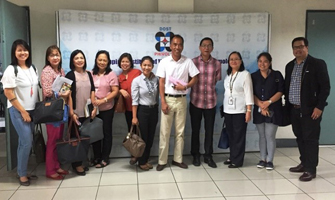 The Philippine Council for Agriculture, Aquatic and Natural Resources Research and Development of the Department of Science and Technology (DOST-PCAARRD) recently approved the program titled, “Agroforestry Support Program for Enhancing Resiliency of Community Based Forest Management Areas (ASPIRE-CBFM)” in April 2019.
The Philippine Council for Agriculture, Aquatic and Natural Resources Research and Development of the Department of Science and Technology (DOST-PCAARRD) recently approved the program titled, “Agroforestry Support Program for Enhancing Resiliency of Community Based Forest Management Areas (ASPIRE-CBFM)” in April 2019.
Spearheaded by the Institute of Agroforestry of the University of the Philippines Los Banos (UPLB-IAF), in collaboration with the Ecosystems Research and Development Bureau of the Department of Environment and Natural Resources (DENR-ERDB) and DOST CALABARZON, the program includes the following projects and respective project leaders:
Project 1, Development of Agroforestry Support System for Sustainable CBFM Areas, Dr. Roberto G. Visco, College of Forestry and Natural Resources (UPLB-CFNR);
Project 2, Assessment of Ecological Services of Agroforestry in Selected CBFM Areas, For. Ma. Lourdes DC Reyes, DENR-ERDB; and
Project 3, Community Empowerment thru S&T (CEST) Project for CBFM Areas, Dr. Lydia Manguiat, DOST-CALABARZON.
The goal of the program is to build resilient and sustainable CBFM communities through the establishment of appropriate agroforestry systems modules as well as livelihood and technology interventions.
This technology transfer program will create potential impacts on the three pillars of sustainable development.
Potential economic impact could be realized through integration of high-value fruit trees and other agricultural crops in existing farms of CBFM beneficiaries that would add value to their major produce. Postharvest processing technologies would also be introduced. This could enhance capital build-up funds of the existing CBFM people’s organizations.
Ecological impact in terms of reducing soil loss through soil and water conservation measures; mitigating climate change through the integration of woody perennials such as fruit trees; and contributing to the ecotourism potential of mangrove areas in coastal communities.
Social impacts in terms of strengthening the people’s organizations and enhancing their social capital through partnership with local development organizations could also be attained.
By 2022, it is expected that the selected CBFM sites’ socioeconomic and biophysical conditions will be improved; ecological services of the current systems and practices will be maintained; S&T interventions will be provided; appropriate agroforestry models will be developed; and institutional capacities of beneficiaries will be enhanced.
The CBFM program was conceived in 1995 primarily as the main strategy towards sustainable forest management. This program became law through Executive Order No. 96, Series of 1995.
CBFM is anchored on the premise that the upland dwellers are important stewards in forest management. CBFM beneficiaries are smallholder farmers cultivating in marginal forestlands. They are prone to land degradation due to biophysical, climatic, and socioeconomic threats.
CBFM areas in CALABARZON are generally described as forestlands with sloping areas prone to soil erosion and landslides, particularly those in Cavite, Batangas, and Laguna. The CBFM site in Quezon is a coastal community which is prone to flooding, storm surge, and sea level rise.
